
Uvođenje Ruby naredbi
1. Što je Ruby?
Ruby je programski jezik otvorenog koda. Tumači se i objektno. Ruby je stvorio Yukihiro Matsumoto. Ruby je dobila ime po dragulju i stoga ga je autor stvorio kao dragulj programskih jezika. ovdje ćemo razgovarati o različitim vrstama Ruby naredbi.
Dizajn Ruby uzima u obzir sljedeće faktore - Jednostavnost, opsežnost, cjelovitost i prenosivost. Ruby radi na većini UNIX platformi. Veliki dio Ruby izgrađen je na Linuxu. Ruby također radi na uobičajenim platformama kao što su Windows, DOS, Mac, itd.
B asic Ruby naredbe
1. Jednostavna naredba za ispis niza u Ruby
#!/usr/bin/ruby –w
puts “Hello, Ruby!”
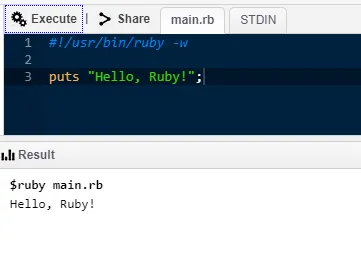
2. Jednostavna naredba za ispis niza nizova pomoću EOF
#!/usr/bin/ruby –w
print < Multiple line string.
First wayEOF
print <<"EOF"; # same as above
Multiple line string.
Second way
EOF#!/usr/bin/ruby –w
print < Multiple line string.
First wayEOF
print <<"EOF"; # same as above
Multiple line string.
Second way
EOF
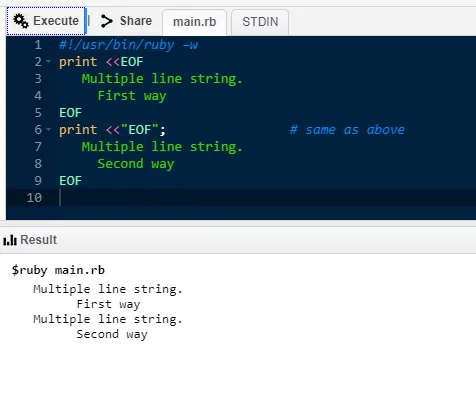
3. Jednostavna naredba za ispis niza više redaka pomoću izvršavanja naredbe
#!/usr/bin/ruby –w
print <<`EOC` # execute commands
echo First Statement
echo Second Statement
EOC

4. Jednostavna naredba za ispis više niza redaka slaganjem.
#!/usr/bin/ruby –w
print <<"a", <<"b" # you can stack them
I said foo.
a
I said bar.
b

5. Ruby BEGIN izjava
#!/usr/bin/ruby
puts "This statement comes later"
BEGIN (
puts "This statement will be printed in the beginning"
)

6. Ruby END izjava
#!/usr/bin/ruby
puts "This is main body"
END (
puts "This block executes in the end"
)
BEGIN (
puts "This block executes in the beginning"
)

7. Ruby jednoredni komentar
#!/usr/bin/ruby
# This is a single line comment.
uts "This is not a comment" # This is again a single line
comment.
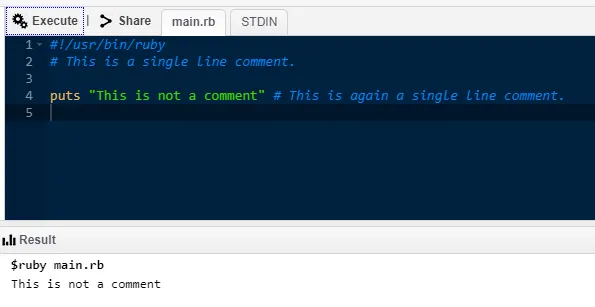
8. Ruby komentar u više linija
#!/usr/bin/ruby=begin
This is a multiple line comment.=end
puts "This is not a comment" # This is a single line comment.

9. Funkcija člana u klasi Ruby. Stvaranje objekta i pozivanje metode.
#!/usr/bin/ruby
class Demo
def testmethod
puts "Hello World!"
end
end
# Now using above class to create objects
object = Demo.new
object.testmethod

10. Globalne varijable u Rubyju
#!/usr/bin/ruby
$globalvariable=123
class FirstClass
def printglobal
puts "Global variable in FirstClass is #$globalvariable"
end
end
class SecondClass
def printglobal
puts "Global variable in SecondClass is #$globalvariable
end
end
class1obj = FirstClass.new
class1obj.printglobal
class2obj = SecondClass.new
class2obj.printglobal
Posredničke naredbe
1. AKO… ELSE u Rubyju
#!/usr/bin/ruby
x = 1
if x > 2
puts "x is greater than 2"
elsif x <= 2 and x!=0
puts "x is 1"
else
puts "I can't guess the number"
end

2. Slučaj u Ruby
<#!/usr/bin/ruby
$age = 17
case $age
when 0 .. 17
puts "Not eligible to vote"
when > 17
puts "Eligible to vote"
else
puts "incorrect age"
end
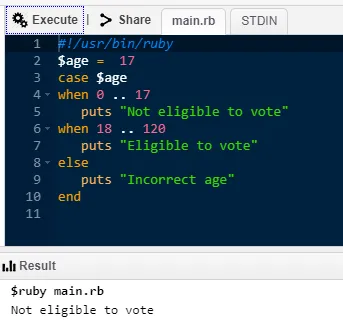
3. Petlje u Ruby
- 3.1. Dok petlje
#!/usr/bin/ruby
$i = 0
$num = 10
while $i <
$num do
puts("Inside the loop i = #$i" )
$i = $i + 1
end
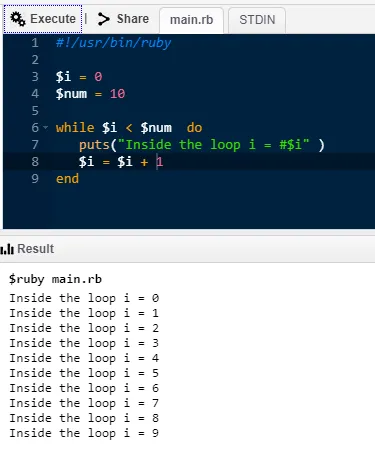
- 3.2. Sve dok Petlja
#!/usr/bin/ruby
$i = 0
$num = 4
until $i > $num do
puts("Inside the loop i = #$i" )
$i = $i + 1;
end

- 3.3. Za petlju
#!/usr/bin/ruby
for i in 0..9
puts "Local variable value is #(i)"
end
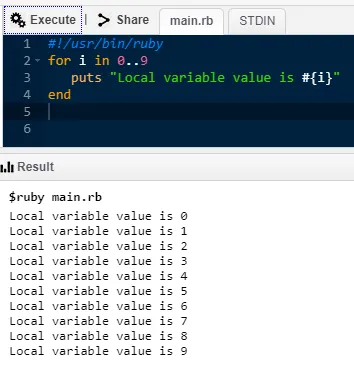
- 3.4. Izjava o prekidu
#!/usr/bin/ruby
for i in 0..5
if i > 3 then
break
end puts "Local variable is #(i)"
end

- 3.5. Sljedeća izjava
#!/usr/bin/ruby
for i in 0..10
if i < 6 then
next
end
puts "Local variable is #(i)"
end
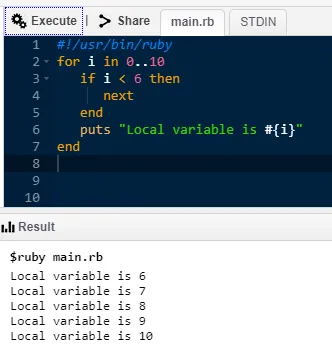
4. Sintaksa metoda u Rubyju
#!/usr/bin/ruby
def test(a1 = "Noodles", a2 = "Pasta")
puts "The food is #(a1)"
puts "The food is #(a2)"
end
test "Burger", "Pizza"
test

5. Izjava o povratu u Ruby
#!/usr/bin/ruby
def testreturn
a = 10
b = 20
c = 30
return a, b, c
endvar1 = testreturn
puts var1
6. Parameterizirana metoda u Rubyju
#!/usr/bin/ruby
def sample (*testparam)
puts "The number of parameters are #( testparam.length)"
for i in 0… testparam.length
puts "The parameters are #(testparam(i))"
end
end
sample "Hello", "123", "ABC", "Programming"
sample "World", "456", "Ruby"
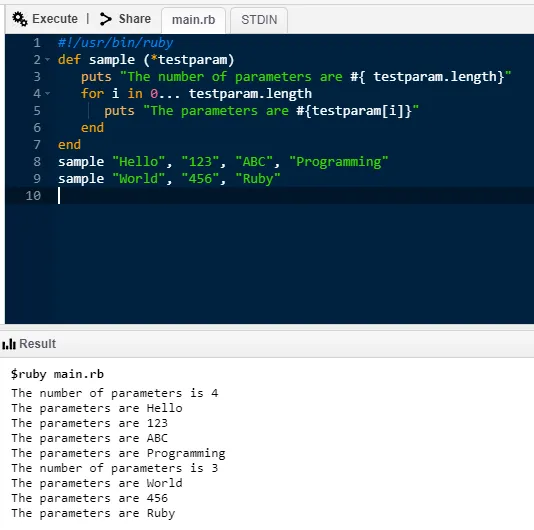
7. Provedbeni blok pomoću izjave o prinosu
#!/usr/bin/ruby
def test
yield
end
test( puts "Hello world")

8. blokovi BEGIN i END u Rubyju
#!/usr/bin/ruby
BEGIN ( # BEGIN block code
puts "BEGIN code block"
)
END (
# END block code
puts "END code block"
)
# MAIN block code
puts "MAIN code block"

9. Zamjena izraza guda u Rubyju
#!/usr/bin/ruby
a, b, c = 1, 2, 3
puts "The value of a is #( a )."
puts "The sum of b and c is #( b + c )."
puts "The average is #( (a + b + c)/3 )."

10. Izrada niza u Ruby
#!/usr/bin/ruby
names = Array.new(10)
puts names.size # returns 10
puts names.length # returns 10
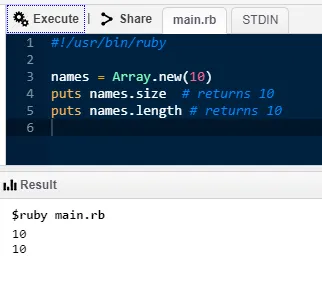
Napredne Ruby naredbe
1. Metode Getter i Setter u Rubyju
#!/usr/bin/ruby -w
# defining a class
class Box
# constructor method
def initialize(l, b, h)
@length, @width, @height = l, b, h
end
# accessor methods
def printLength
@length
end
def printBreadth
@breadth
end
def printHeight
@height
end
end
# create
an object
box = Box.new(10, 30, 40)
# use accessor methods
l = box.printLength()
b = box.printBreadth()
h = box.printHeight()
puts "Box Length : #(l)"
puts "Box Breadth : #(b)"
puts “Box Height : #(h)”

2. Pisanje zajedničkih skripti pristupnika pomoću Rubyja
#!/usr/bin/ruby "
require 'cgi'
cgi = CGI.new
puts cgi.header
puts "This is a test
3. Programiranje utičnica pomoću Rubyja
- 3.1. Jednostavni primjer poslužitelja koji koristi Ruby
require 'socket' # Get sockets from stdlib
server = TCPServer.open(8090) # listen on port 8090
loop ( # Running the server infinitely
client = server.accept # Connecting client wait time
client.puts(Time.now.ctime) # send time to client
client.puts "Closing the connection!"
client.close # Client disconnect
)
- 3.2. Jednostavan primjer klijenta koji koristi Ruby
require 'socket' # Get socket from stdlib
hostname = 'localhost' # Set hostname
port = 8090 # Set portsock = TCPSocket.open(hostname, port)
while line = sock.gets # Read lines from the socket
puts line.chop # print with platform line terminator
end
sock.close # Socket closing
4. Multithreading primjer u Ruby-u
#!/usr/bin/ruby
def function1
i = 0
while i<=2
puts "function1 at: #(Time.now)"
sleep(2) i = i+1
end
end
def function2
j = 0
while j<=2
puts "function2 at: #(Time.now)"
sleep(1)
j = j+1
end
end
puts "Started At #(Time.now)"
t1 = Thread.new(function1())
t2 = Thread.new(function2())
t1.join
t2.join
puts "End at #(Time.now)"
Savjeti i trikovi za korištenje Ruby naredbi
Budući da rad na bilo kojem programskom jeziku zahtijeva znanje i spremnost za nadogradnju, ni ovaj slučaj nije iznimka. Korištenje osnovnih naredbi i vježbanje i ovladavanje naredbama ključ je za ovladavanje ovim prekrasnim jezikom.
Zaključak - Ruby naredbe
Naredba Ruby je programski jezik slobodnog i otvorenog koda; fleksibilan je i bogat značajkama. Kao što ime sugerira, rubin je doista dragulj jezik koji dolazi s vrlo niskim ulaznim cijenama. Njegova mogućnost plug and play i lako čitljiva sintaksa čine ga vrlo korisnim. To je napredni scenaristički objekt koji sažima i za svoju popularnost.
Preporučeni članci
Ovo je vodič za Ruby naredbe. Ovdje smo razgovarali o osnovnim Ruby naredbama i nekim unaprijed Ruby naredbama. Možete pogledati i slijedeći članak kako biste saznali više.
- Kako koristiti naredbe selena?
- Vrhunske iskričaste naredbe
- Naredbe za HBase
- Kako se koriste tableau naredbe?
- Programiranje utičnica u Pythonu